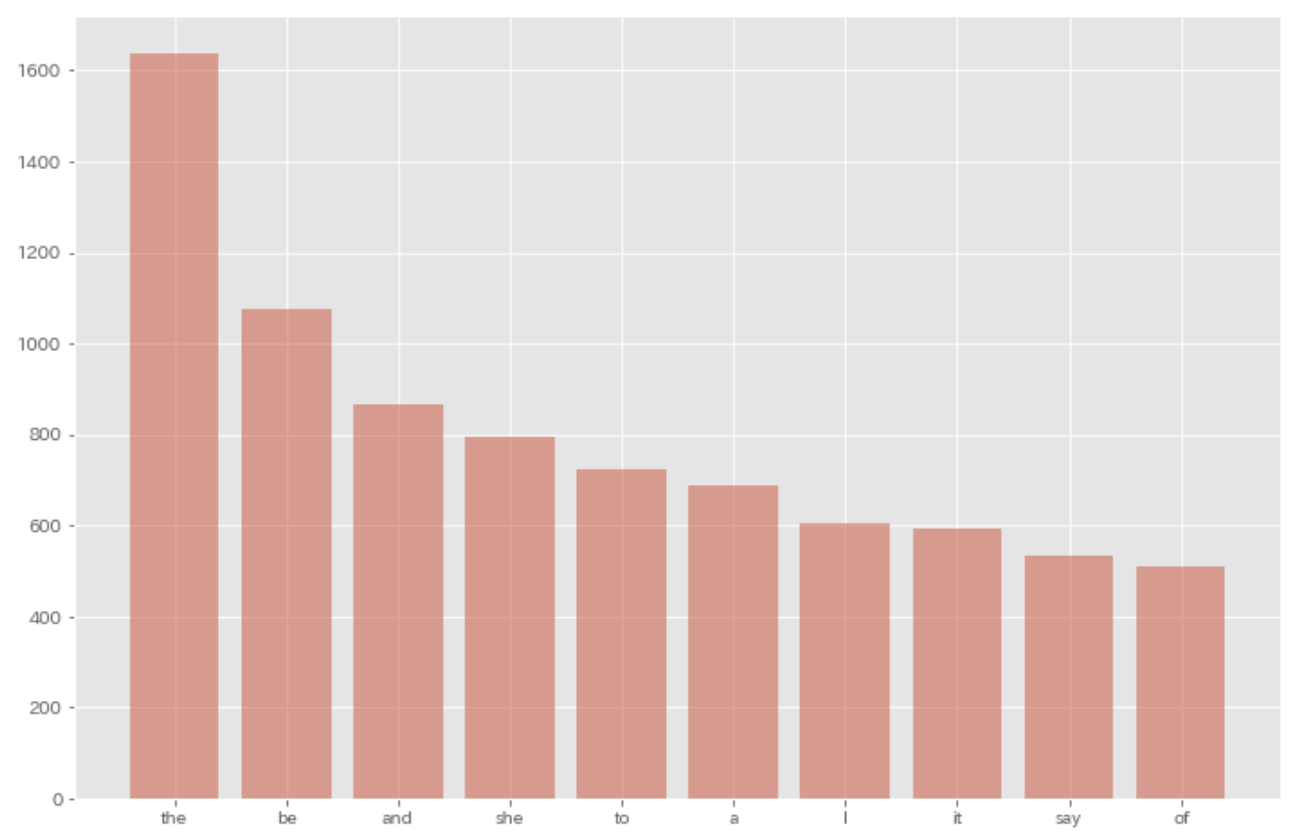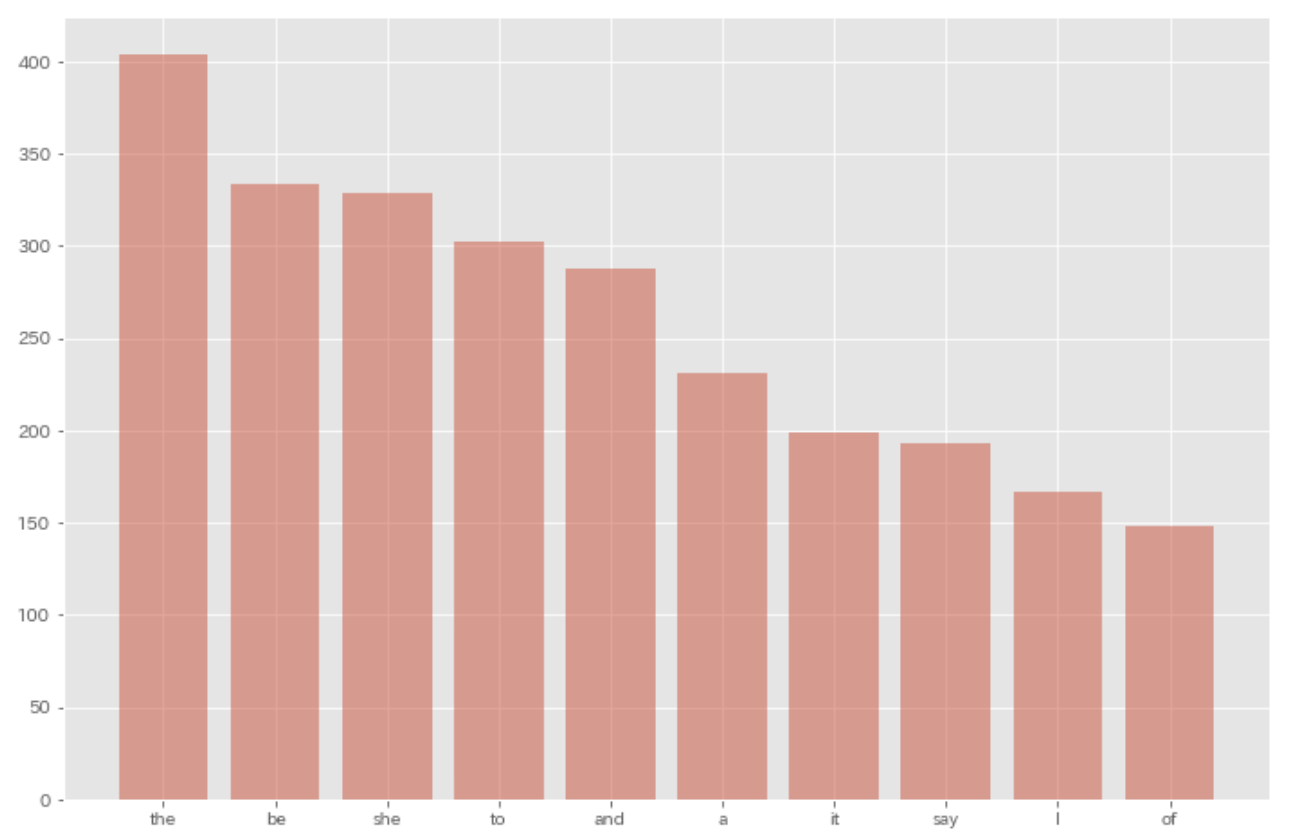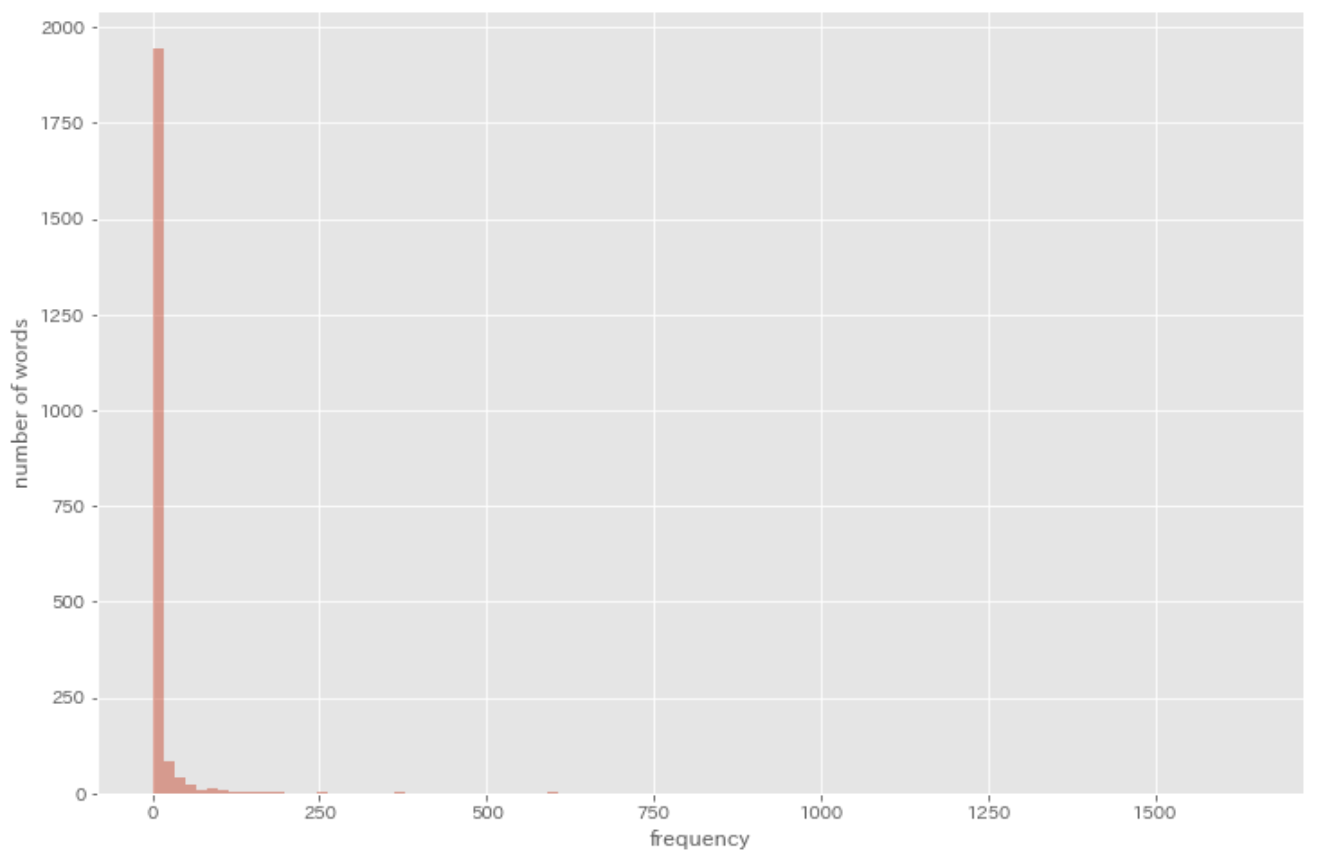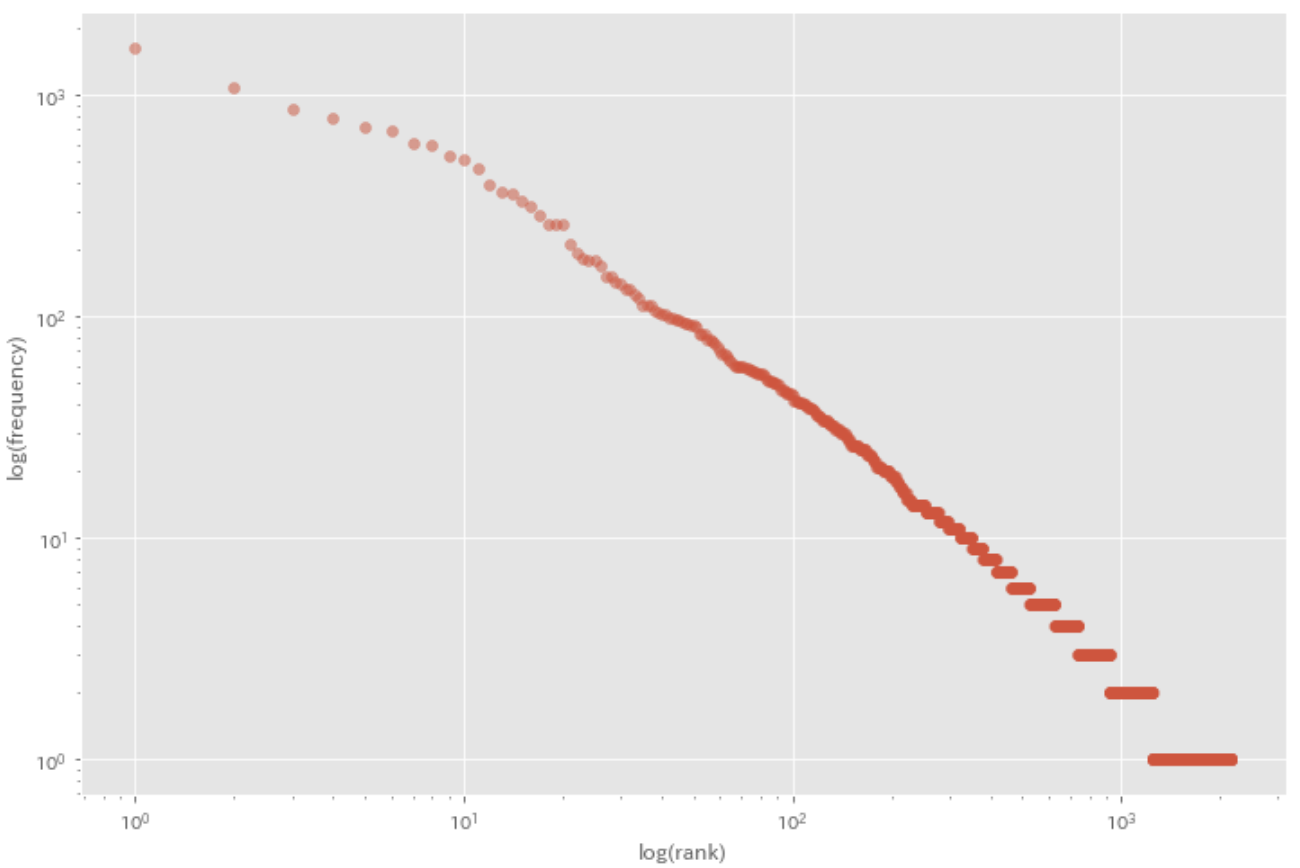Pengantar
Tokyo Institute of Technology telah menciptakan dan memelihara koleksi latihan NLP yang disebut "NLP 100 Exercise".
Dalam artikel ini, saya akan memberikan contoh jawaban untuk "Chapter 4: POS tagging".
Pengaturan lingkungan
Arsip zip alice.zip berisi novel Alice's Adventures in Wonderland (ditulis oleh Lewis Carroll) yang didistribusikan di Project Gutenberg, sebagai file teks
alice.txt. Terapkan penanda bagian dari ucapan (POS) ke file teks, dan simpan hasilnya di file lain. Menerapkan program yang membaca hasil penandaan POS dan melakukan pekerjaan.Untuk kenyamanan Anda, arsip zip juga menyertakan
alice.txt.conll, novel dengan label bagian dari ucapan yang diprediksi oleh Stanford CoreNLP. Mungkin ada baiknya untuk menggunakan matplotlib atau [Gnuplot] (http://www.gnuplot.info/) untuk masalah 37, 38, dan 39.
$ wget https://nlp100.github.io/data/alice.zip
$ unzip alice.zip
$ head -n 15 alice.txt.conll
1 ALICE ALICE NNP _ _ _
2 'S 's POS _ _ _
3 ADVENTURES ADVENTURES NNP _ _ _
4 IN in IN _ _ _
5 WONDERLAND WONDERLAND NNP _ _ _
1 Lewis Lewis NNP _ _ _
2 Carroll Carroll NNP _ _ _
1 THE the DT _ _ _
2 MILLENNIUM MILLENNIUM NNP _ _ _
3 FULCRUM FULCRUM NNP _ _ _
4 EDITION EDITION NNP _ _ _
5 3.0 3.0 CD _ _ _
30. Reading the result
Menerapkan program yang membaca hasil penandaan bagian ucapan. Di sini, representasikan sebuah kalimat sebagai sebuah daftar objek pemetaan, yang masing-masing mengasosiasikan bentuk permukaan, lemma (bentuk dasar), tag part-of-speech dengan kunci
text,lemma,pos. Gunakan representasi ini dalam soal-soal lainnya.
sentences = []
morphs = []
with open('./alice.txt.conll', mode='r') as f:
for line in f:
if line != '\n':
fields = line.split('\t')
if fields[1] == '':
continue
else:
morph = {
'text': fields[1],
'lemma': fields[2],
'pos': fields[3],
}
morphs.append(morph)
else:
if len(morphs) > 0:
sentences.append(morphs)
morphs = []
from pprint import pprint
for morpheme in sentences[:3]:
pprint(morpheme)
[{'lemma': 'ALICE', 'pos': 'NNP', 'text': 'ALICE'},
{'lemma': "'s", 'pos': 'POS', 'text': "'S"},
{'lemma': 'ADVENTURES', 'pos': 'NNP', 'text': 'ADVENTURES'},
{'lemma': 'in', 'pos': 'IN', 'text': 'IN'},
{'lemma': 'WONDERLAND', 'pos': 'NNP', 'text': 'WONDERLAND'}]
[{'lemma': 'Lewis', 'pos': 'NNP', 'text': 'Lewis'},
{'lemma': 'Carroll', 'pos': 'NNP', 'text': 'Carroll'}]
[{'lemma': 'the', 'pos': 'DT', 'text': 'THE'},
{'lemma': 'MILLENNIUM', 'pos': 'NNP', 'text': 'MILLENNIUM'},
{'lemma': 'FULCRUM', 'pos': 'NNP', 'text': 'FULCRUM'},
{'lemma': 'EDITION', 'pos': 'NNP', 'text': 'EDITION'},
{'lemma': '3.0', 'pos': 'CD', 'text': '3.0'}]
[{'lemma': 'chapter', 'pos': 'NN', 'text': 'CHAPTER'},
{'lemma': 'i.', 'pos': 'NN', 'text': 'I.'},
{'lemma': 'down', 'pos': 'IN', 'text': 'Down'},
{'lemma': 'the', 'pos': 'DT', 'text': 'the'},
{'lemma': 'Rabbit-Hole', 'pos': 'NNP', 'text': 'Rabbit-Hole'}]
31. Verbs
Mengekstrak bentuk permukaan semua kata kerja yang muncul dalam teks.
result = set()
for sentence in sentences:
for morph in sentence:
if morph['pos'].startswith('VB'):
result.add(morph['text'])
print(list(result)[:10])
['flashed', 'takes', 'died', 'play', 'produced', 'favoured', 'exclaimed', 'is', 'bring', 'folded']
32. Base forms of verbs
Ekstrak lema dari semua kata kerja yang muncul dalam teks.
result = set()
for sentence in sentences:
for morph in sentence:
if morph['pos'].startswith('VB'):
result.add(morph['lemma'])
print(list(result)[:10])
['play', 'jog', 'bring', 'receive', 'settle', 'drop', 'continue', 'nurse', 'last', 'cross-examine']
33. A of B
Mengekstrak frasa kata benda dalam bentuk "A dari B", di mana A dan B adalah kata benda.
result = set()
for sentence in sentences:
for i in range(1, len(sentence) - 1):
if sentence[i - 1]['pos'].startswith('NN') and sentence[i]['text'] == 'of' and sentence[i + 1]['pos'].startswith('NN'):
result.add(sentence[i - 1]['text'] + ' ' + sentence[i]['text'] + ' ' + sentence[i + 1]['text'])
print(list(result)[:5])
['Adventures of hers', 'way of nursing', 'state of mind', 'clapping of hands', 'piece of rudeness']
34. A B
Ekstrak frasa kata benda terpanjang yang terdiri dari kata benda berurutan.
result = set()
for sentence in sentences:
nouns = ''
count = 0
for morph in sentence:
if morph['pos'].startswith('NN'):
if count == 0:
nouns = morph['text']
else:
nouns = ' '.join([nouns, morph['text']])
count += 1
elif count >= 2:
result.add(nouns)
nouns = ''
count = 0
else:
nouns = ''
count = 0
if count >= 2:
result.add(nouns)
pprint(list(result)[:10])
['summer days',
'Ou est ma chatte',
'CHAPTER I.',
'feather flock',
'head downwards',
'glass box',
'ITS WAISTCOAT-POCKET',
'Miss Alice',
'Mock Turtle',
'garden door']
35. Frequency of words
Dapatkan daftar kata dan frekuensi kemunculannya yang diurutkan berdasarkan urutan frekuensi.
from collections import defaultdict
result = defaultdict(int)
for sentence in sentences:
for morph in sentence:
if morph['pos'] not in [',', '.', ':', '$', '#', '"', "''", '``', '-LRB-', '-RRB-']:
result[morph['lemma']] += 1
result = sorted(result.items(), key=lambda x: x[1], reverse=True)
for res in result[:10]:
print(res)
('the', 1639)
('be', 1076)
('and', 866)
('she', 794)
('to', 725)
('a', 688)
('I', 604)
('it', 594)
('say', 532)
('of', 511)
36. Top-ten frequent words
Memvisualisasikan sepuluh kata yang paling sering muncul dan frekuensinya dengan bagan (mis. bagan batang).
$ pip install japanize_matplotlib
import matplotlib.pyplot as plt
plt.style.use('ggplot')
result = defaultdict(int)
for sentence in sentences:
for morph in sentence:
if morph['pos'] not in [',', '.', ':', '$', '#', '"', "''", '``', '-LRB-', '-RRB-']:
result[morph['lemma']] += 1
result = sorted(result.items(), key=lambda x: x[1], reverse=True)
plt.figure(figsize=(12, 8))
plt.bar([res[0] for res in result[0:10]], [res[1] for res in result[0:10]], alpha=0.5)
plt.show()

37. Top-ten words co-occurring with ‘Alice’
Ekstrak daftar kata yang muncul bersamaan dengan kata "Alice". Visualisasikan dengan bagan (mis. bagan batang) sepuluh kata teratas yang muncul bersama dengan kata "Alice" dan frekuensinya.
result = defaultdict(int)
for sentence in sentences:
if 'Alice' in [morph['text'] for morph in sentence]:
for morph in sentence:
if morph['pos'] not in [',', '.', ':', '$', '#', '"', "''", '``', '-LRB-', '-RRB-'] and morph['text'] != 'Alice':
result[morph['lemma']] += 1
result = sorted(result.items(), key=lambda x: x[1], reverse=True)
plt.figure(figsize=(12, 8))
plt.bar([res[0] for res in result[0:10]], [res[1] for res in result[0:10]], alpha=0.5)
plt.show()

38. Histogram
Gambarkan histogram frekuensi kata (sumbu x adalah rentang skalar yang mewakili frekuensi mulai dari 1 hingga frekuensi terbesar dari kata yang diberikan di seluruh korpus, dan sumbu y adalah jumlah kata unik yang termasuk dalam hitungan nilai x).
result = defaultdict(int)
for sentence in sentences:
for morph in sentence:
if morph['pos'] not in [',', '.', ':', '$', '#', '"', "''", '``', '-LRB-', '-RRB-']:
result[morph['lemma']] += 1
result = result.values()
plt.figure(figsize=(12, 8))
plt.hist(result, bins=100, alpha=0.5)
plt.xlabel('frequency')
plt.ylabel('number of words')
plt.show()

39. Zipf’s law
Plot grafik log-log dengan sumbu x adalah urutan peringkat dan sumbu y adalah frekuensi.
result = defaultdict(int)
for sentence in sentences:
for morph in sentence:
if morph['pos'] not in [',', '.', ':', '$', '#', '"', "''", '``', '-LRB-', '-RRB-']:
result[morph['lemma']] += 1
result = sorted(result.items(), key=lambda x: x[1], reverse=True)
ranks = [res + 1 for res in range(len(result))]
values = [res[1] for res in result]
plt.figure(figsize=(12, 8))
plt.scatter(ranks, values, alpha=0.5)
plt.xscale('log')
plt.yscale('log')
plt.xlabel('log(rank)')
plt.ylabel('log(frequency)')
plt.show()

Referencsi